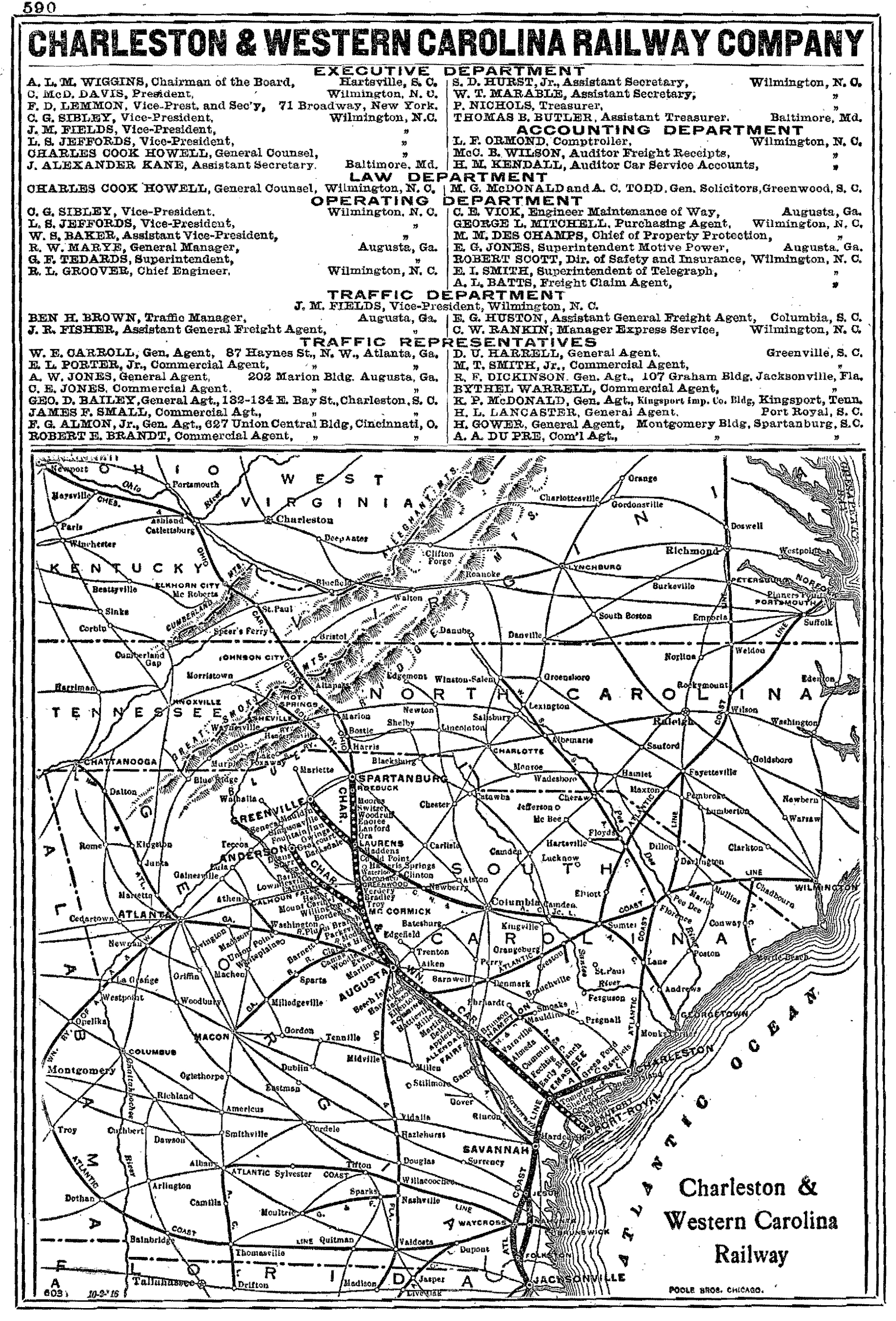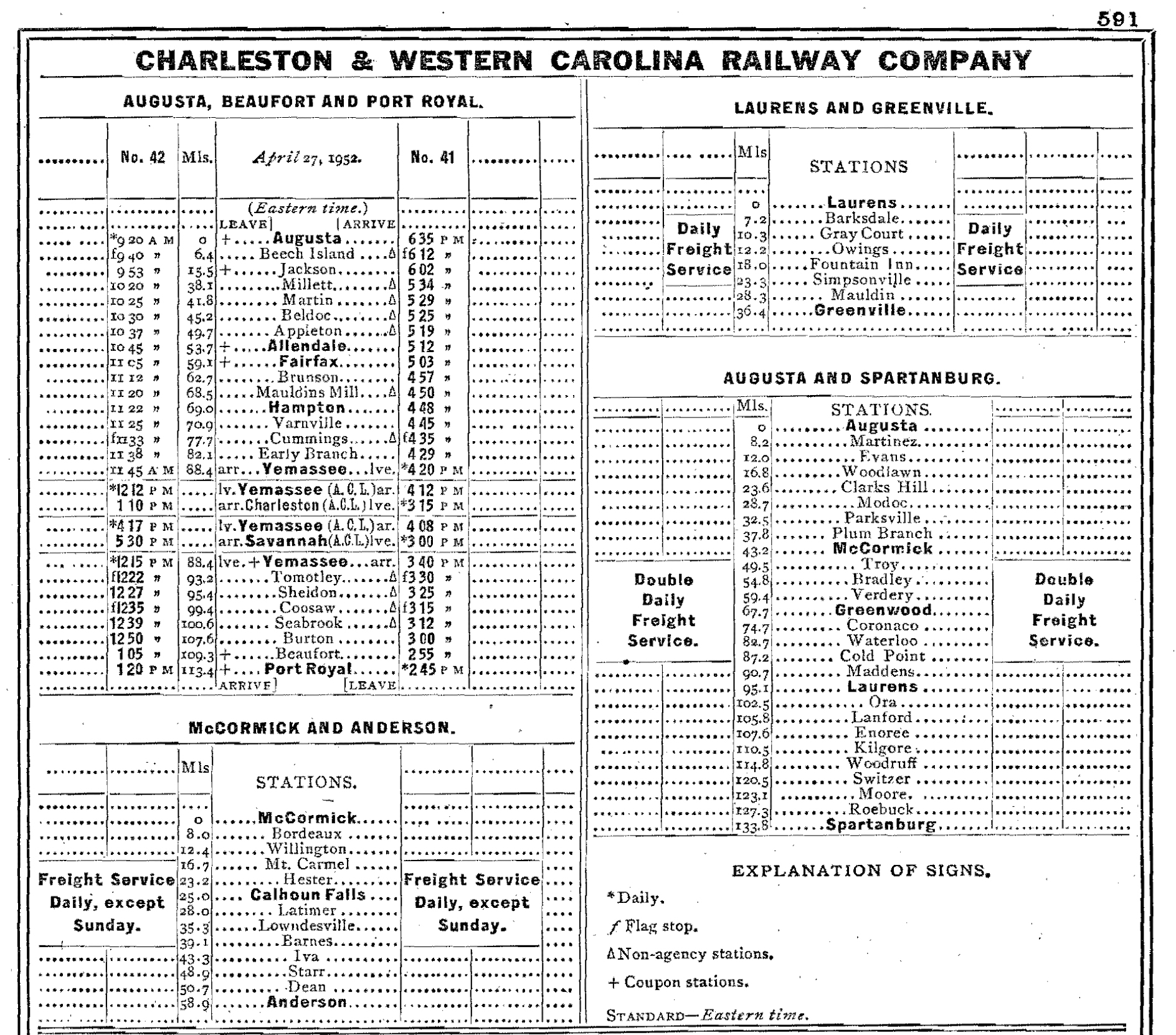Charleston and Western Carolina Railway: Map, History, Timetables
Last revised: August 23, 2024
By: Adam Burns
The Charleston and Western Carolina Railway (C&WC) was a system that operated in the southeastern United States during the late 19th and early 20th centuries.
It was established in 1896 after a reorganization of the Port Royal and Augusta Railway and the Port Royal and Western Carolina Railway.
The C&WC served areas in South Carolina and Georgia, with its main line running from Port Royal and to Spartanburg and Anderson, South Carolina. Its route also briefly passed into Georgia at Augusta and passengers could reach Charleston via the Atlantic Coast Line.
In 1959, it was fully incorporated into the Atlantic Coast Line Railroad, which later became part of CSX Transportation.
History
The genesis of the Charleston and Western Carolina Railway is a story interwoven with the early expansion of railroads in the United States during the 19th Century.
This system found its beginnings as two separate companies - the Port Royal and Augusta Railway (PR&A) and the Port Royal and Western Carolina Railway Company (PR&WC).
Both of these systems could trace their heritage back much further, notably the PR&A, which was completed in 1873 between its namesake towns. The PR&A was acquired by the Central Rail Road & Banking Company of Georgia (Central of Georgia) in 1881 as the railroad sought expansion into South Carolina.
In 1886 it merged a leased property, the Augusta and Knoxville Railroad (Augusta-Greenwood), as well as accompanying branches to Spartanburg, Anderson, and Greenville into the Port Royal and Western Carolina Railway.
In his book, "Central of Georgia Railway and Connecting Lines," author Richard Prince notes that the Central Rail Road & Banking Company of Georgia lost control of the PR&WC and PR&A in 1894 after the Legislature of South Carolina passed laws forcing the parent to give up these properties.
These two establishments were then merged in 1896 to form what we know today as the Charleston and Western Carolina Railway. The 341-mile system was acquired by the Atlantic Coast Line the following year in 1897 by operated it as an independent railroad.
The initial service of the C&WC included numerous essential cities across Georgia and South Carolina. This comprehensive reach across the two southeastern states of Georgia and South Carolina was a testament to its expanse and influence during its operational years.
The C&WC's critical purpose lay in its mission to transform the transportation landscape of the Southeast.
At A Glance
Port Royal - Augusta - Spartanburg McCormick - Anderson, South Carolina Laurens - Greenville/Spartanburg | |
Its routes facilitated the swift movement of goods, individuals, and information between some of the era's most notable cities, making it a significant component of the region's economic and logistical fabric.
As a means of transport, the railroad moved a variety of freight. Key among these goods were agricultural products and manufactured goods, an indication of the surrounding region's economic activities.
This valuable service was instrumental in supporting local economies and connected communities, aiding both the commercial and personal aspects of life for the people in this region.
The railway was known for its passenger service, which continued to run for several years. However, similar to numerous railway operations of that era, passenger services eventually ceased.
The cessation occurred in 1952, as the rise of automobiles and the increasing accessibility of air travel made them economically nonviable.
System Map (1952)

Atlantic Coast Line
Change swept through the operations of the Charleston and Western Carolina Railway in 1897 when it was incorporated into the Atlantic Coast Line. This incorporation marked another phase in the railway's existence, widening its reach and bolstering its operations.
The Atlantic Coast Line Railroad, with the Charleston and Western Carolina as one of its integral components, continued to transmit goods, people, and ideas across the southeast.
The ACL was one of the Southeast's largest systems, operating a network of nearly 5,500 route miles by the mid-1950s that connected Richmond, Virginia with the Carolinas, Georgia, Alabama, and Florida.
The ACL's exceptional service established an unforgettable legacy dedicated to enhancing transport, trade, and ultimately, the quality of life within the communities it served.
Despite its incorporation, the identity of the Charleston and Western Carolina didn't entirely fade. Instead, it remained an intrinsic part of the broader operational network of the ACL, lending its name and routes to the larger conglomerate.
Over the years, this historic railway has undergone multiple transitions. Its operations as the Charleston and Western Carolina ended in 1959, when it was fully absorbed into the Atlantic Coast Line.
Interestingly, the ACL itself would later merge with the Seaboard Air Line Railroad. This union, which occurred in 1967, birthed the Seaboard Coast Line Railroad, a further testament to the evolving landscape of railway operations.
CSX Transportation
Fast forward to 1980, the Seaboard Coast Line became incorporated with other railway services to form what we now know as CSX Transportation. Today, the CSX operates on much of the original Charleston and Western Carolina Railway.
Despite centuries of change and corporate handovers, the routes and railyards of the historical Charleston and Western Carolina Railway live on. They exist as a skeleton of the past, still silently serving their purpose as arteries of commerce in a modern world dominated by different technologies.
The remnants of the Charleston and Western Carolina Railway today offer a tangible glance into the past. Under CSX Transportation much of the system survives as the Augusta Subdivision, McCormick Subdivision, and Spartanburg Subdivision.
In addition, the former Laurens to Greenville branch is operated as the Carolina Piedmont Railroad.
Legacy
While the use of railways has dwindled, replaced by modern means of transportation, one cannot overlook the integral role played by institutions like the Charleston and Western Carolina in shaping the socioeconomic aspects of the United States.
Indeed, the railroad played a crucial role in catalyzing the growth of cities such as Charleston and Augusta, spreading wealth, commodities, and opportunities for all that it connected.
History-filled towns like Spartanburg owe some of their economic and infrastructural development to the convenient access and connectivity provided by the C&WC.
Beyond its role as an economic driver, the C&WC was also embedded in the fabric of the region’s social history.
Imagine the tearful goodbyes and joyous reunions on its platforms, the countless stories of individuals that unraveled in its coaches, and the sense of thrilling adventure that a simple train ride could offer to the curious traveler.
The mighty locomotives that once roared along its tracks have been replaced by the quieter, more efficient diesels that are now a common sight on the former C&WC lines.
The humble origins, the swift expansion, the eventual absorption into CSX Transportation is a tale of resilience, adaptation, and continuous growth.
Yet, as we move further into the 21st century, it's essential to remember that the well-trodden rails of the Charleston and Western Carolina hold more than the echo of steel wheels. They are the silent bearers of a timeless heritage – a testament to the spirit of a people and an era that shaped modern America.
As one travels by train today along parts of the original Charleston and Western Carolina Railway, one can appreciate the intricate planning and immense effort that went into the creation of the original operation.
As CSX Transportation continues its operations today, one can only marvel at its journey. From the C&WC's beginnings to the current operation under the CSX, the transformation is as monumental as it is profound.
The Charleston and Western Carolina is a tale of progress; a testament to human ingenuity, and a symbol of a country that grew rapidly while holding tight to its values of diligence, progress, and resilience.
It may not exist in its original form today, but the C&WC lives on - in the heart of the landscape it once traversed, in the towns it helped flourish, in the modern transport system that it seamlessly blended into, and in the memories of the people it served.
Timetables (1952)

The spirit of unity, progress, and industry embodied in the railroad continues to resonate in the railway lines that crisscross the land today, motivating a new era of railway enthusiasts, engineers, and historians.
The C&WC has left an indelible mark on the American landscape, encapsulating a significant part of the nation's historical narrative.
As the successor to the Atlantic Coast Line and a contributor to modern-day CSX Transportation, its legacy continues – a constant reminder of the railroad's timeless and essential role in shaping our world, sustaining communities, and paving the way for future generations.
Sources
- Goolsby, Larry. Atlantic Coast Line Passenger Service: The Postwar Years. Lynchburg: TLC Publishing, Inc., 1999.
- Goolsby, Larry. Seaboard Air Line Passenger Service, The Streamlined Era. Forest: TLC Publishing, 2011.
- Schafer, Mike. Classic American Railroads, Volume III. Osceola: MBI Publishing, 2003.
Contents
Recent Articles
-
Washington Short Line Railroads: A Complete Guide
Apr 05, 25 11:08 AM
This information highlights the currently active short line railroads operating within the state of Washington. -
Virginia Short Line Railroads: A Complete Guide
Apr 05, 25 11:05 AM
Virginia is a prominent southern state home to many short line railroads, all of which are featured here. -
Vermont Short Line Railroads: A Complete Guide
Apr 05, 25 10:03 AM
As the fifth smallest state, Vermont is home to only a few short lines. However, these systems are steeped in history due to New England's rich railroading heritage.